Martin B-26 Marauder 42-107635, Skibbereen, Cork
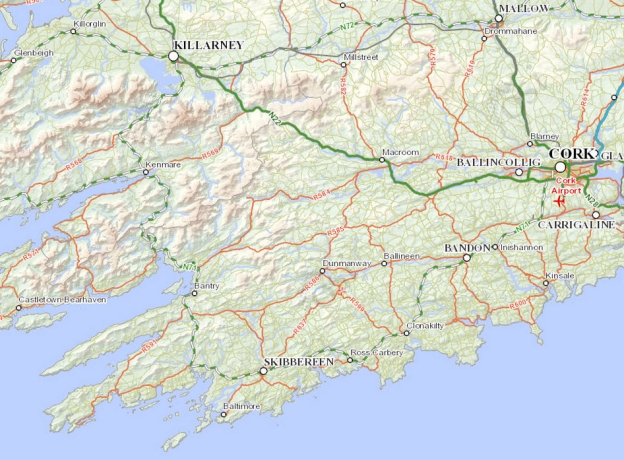 The 16th
of March 1944 would witness the first of two aircraft landings
in a patch of ground on the close outskirts of the west Cork
town of Skibbereen. The landing took place on the area known as
'The Marsh' adjacent to Skibbereen's old railway station.
The 16th
of March 1944 would witness the first of two aircraft landings
in a patch of ground on the close outskirts of the west Cork
town of Skibbereen. The landing took place on the area known as
'The Marsh' adjacent to Skibbereen's old railway station.
The United States Army Air Forces (USAAF) official crash report
on this aircraft contains a statement from F/O Jones Jr about
the flight and lead up to the landing. A summary of the event as
determined by the investigating committee reads as follows: 1.
This aircraft experienced difficulties in navigation as a
result of radio Compass failure, in the early morning hours of
the flight. The pilot reported fuel consumption had been
progressively increasing from unknown causes since leaving
South America. As a result, the aircraft arrived over the
South coast of Eire after 7 hours and 5 minutes of flying with
approximately 50 minutes of fuel left. Being unable to find a
suitable landing field, the pilot made a forced landing with
gear up in a race track near the town of Skibbereen, Eire at
1015 GMT with 25 minutes of fuel left. None of the crew
injured but the aircraft was seriously damaged and will have
to be salvaged. The term salvaged as used in USAAF terms
meant that the aircraft was beyond repair, whereas in British
terminology, this just referred to the recovery of an air frame
be it repairable or not. The same report records the damage as
being, Damage to the fuselage: Nose glass broken, Forward
Section Fuselage, bomb bay doors buckled; Engines: Major
Overhaul required and the propellers were a Complete Wreck.
This photo is apparently of the aircraft, USAAF serial number
42-107635, sitting forlornly on The Marsh on the day of the
landing. It is unknown who took this photo but it is
possible it was Frank Roche, an avid local photographer.
This scan was provided by D. Smyth in 2017. The appearance
of the aircraft would suggest that it was finished in unpainted
natural metal finish with the dark anti glare patch visible
forward of the cockpit windows.
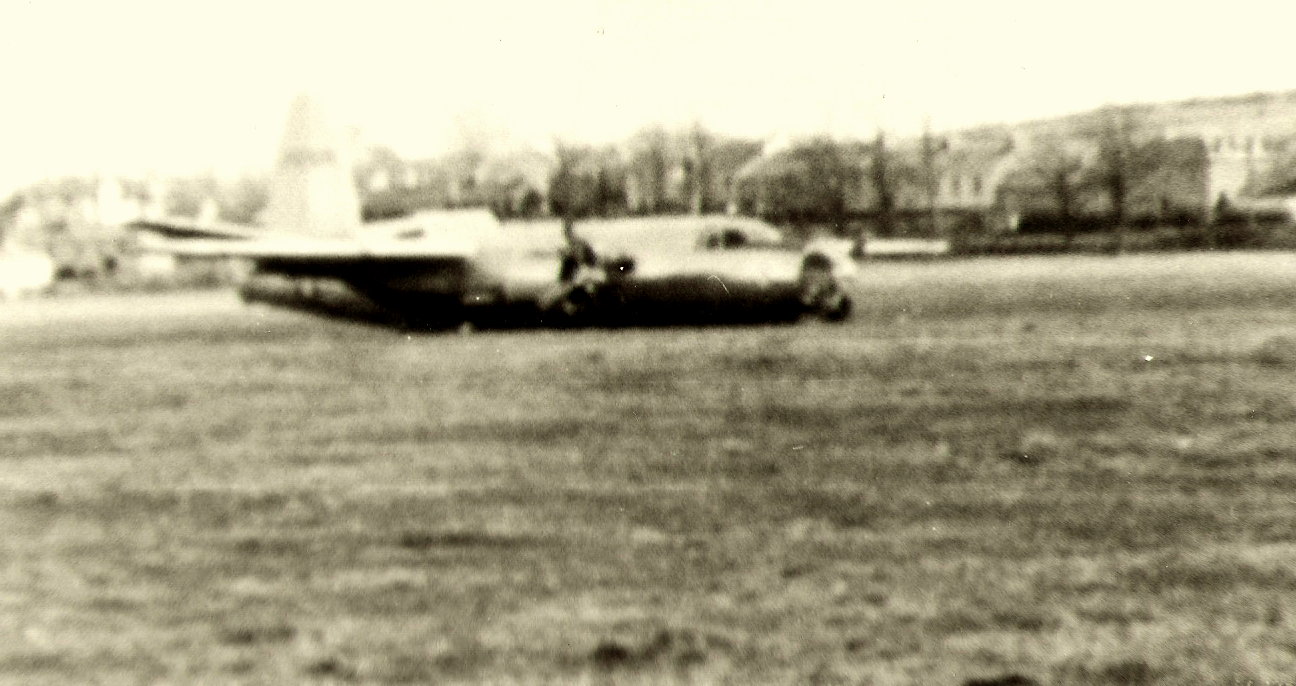
A long range fuel tank that the crew had jettisoned over the sea was also recovered by fishermen during this time.
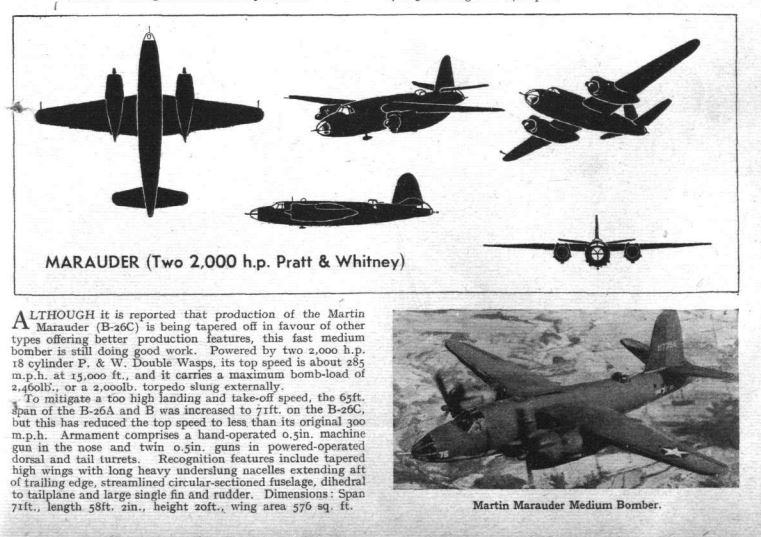 The B-26 was a twin
engine medium bomber produced by the Glenn L Martin Airplane
Company in Middle River, Maryland though this aircraft, a
B-26C-25-MO model was actually built in Omaha, Nebraska. Joe
Baugher's website provides an excellent short history of the type. The image shows
a 1944 aircraft recognition report from the February 3rd, 1944
edition of Flight magazine published in the UK. Videos about the
B-26 can be viewed on the Youtube.com website.
The B-26 was a twin
engine medium bomber produced by the Glenn L Martin Airplane
Company in Middle River, Maryland though this aircraft, a
B-26C-25-MO model was actually built in Omaha, Nebraska. Joe
Baugher's website provides an excellent short history of the type. The image shows
a 1944 aircraft recognition report from the February 3rd, 1944
edition of Flight magazine published in the UK. Videos about the
B-26 can be viewed on the Youtube.com website.
The crew of five on board received no reported injuries and
were looked after by locals until the arrival of the Irish
Military after which they were brought to Collins Barracks in
Cork. They were provided with refreshments and at 16:45 on
the day of the crash they were sent to the border under the
escort of Lt. Healy of the Irish Air Corps. Major Sprague
the US Military Attache had traveled to Cork that day and met
with the men in Collins Barracks, Cork just prior to their
departure. A series of telegrams was sent by the legation
in Dublin and then by the USAAF in Nutts Corner, Northern
Ireland with details of the crew and incident. These
relate that the aircraft's home station was Morrison Field,
Florida, presumably the starting point of the ferry flight.
The five were sent north to Northern Ireland and thence to England where Enoch Miles returned to flying with Air Transport Command. The other four men it was determined, went on to be posted to the 322nd Bomb Group, where the were split up among other existing crews.
The Crew of B-26 42-107635 which landed in Skibbereen had their
names recorded by the Irish Military who attended the crash
sight. Their names were:
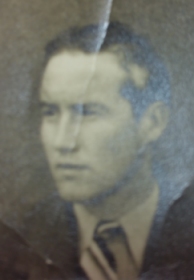 F/O Oscar T JONES Jr T-185393, Pilot |
2/Lt James H DELOACH O-691088, Pilot |
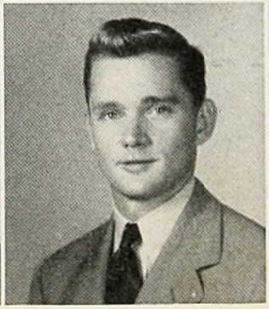 2/Lt Enoch A MILES O-445777, Navigator (1942 College photo) |
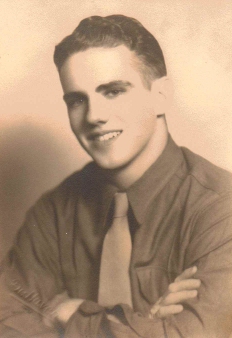 Sgt Richard W HARBORDT 38364743 |
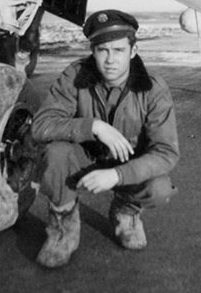 Sgt Billy J KERR 18184074 |
Following their release into Northern Ireland, they are found
posted into the 3rd Replacement and Training Squadron, BOMB at
Toome airfield in Northern Ireland.
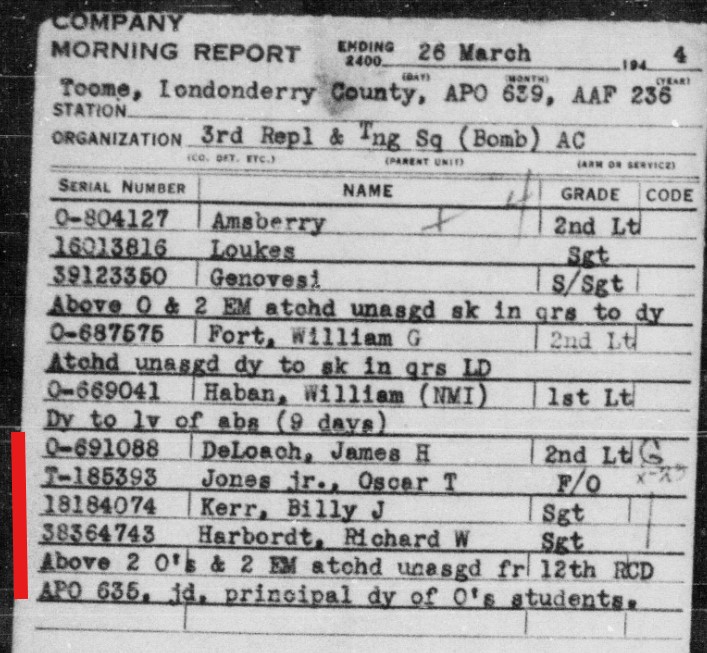
Oscar T JONES Jr was born in November 1921 in Oklahoma,
to Corrine and Oscar T Jones. In the 1930 census he was residing
in Strike Axe, Osage County with his parents and three siblings,
Gerald, Edwin and Isabelle. By the time of the 1940 census
however, and based on later records from the time of his death,
he was enumerated at Randolph Field, based there with the United
States Army Air Corps. In that census record he is recorded as
being a Weather Observer with the airfields Headquarters
Squadron. The next mention found of him is his landing in
Ireland, the subject of this webpage.
Oscar's record of the events leading up the landing in Ireland
are recorded in the USAAF crash report as follows: After running our engines on the ground for
forty (40) minutes at Marrakech awaiting tower permission to
take off, we left the runway at 0242 GCT. Our scheduled take
of time was 0110 GCT, and we were ready to go at 0110 GCT.
The flight was uneventful until we passed Spain then the
radio compass ceased to function properly, the trailing wire
antenna was lost during flight. Noticed that the engines
were using more fuel than normal shortly after sunrise. We
flew instrument weather at 9500 ft for two (2) hours, during
this time we must have been blown to the west. After turning
on a heading into destination we sighted land in scattered
cloud conditions in front and to the left of us. This proved
to be Eire, we then had fifty (50) minutes of fuel left. The
weather to the north was instrument. Made a forced landing
with twenty-five (25) minutes of fuel remaining, at
Skibbereen, Eire at 1015 GCT
The US National Archives has a single page form which was signed
by Oscar after his 'escape' from Ireland. This was a standard
format document which an escapee had to be vouched for by
another officer, in this case a Major Henry C Newcomber O-21770.
This officer was the Commanding Officer of the 451st Bomb
Squadron of the 322nd Bomb Group during the war, receiving the
award of Distinguished Flying Cross for his duties
On 15th June, 1944, Oscar Jones was flying in another of the
322nd BG's B-26's as co-pilot when James Deloach was shot down.
The Republican and Herald of Pottsville, Pennsylvania published
the following short article in October 1944 mentioning Oscar:
Lt. Oscar T. Jones, Jr.,
of 238 East Centre street, is a member of “The Annihilators,”
stationed at Ninth Air Force bomber base in the European theatre
of operations.
He was one of those who
participated in a mission blasting a gap in the Siegfried
Line for Gen. Patton’s break-through lunge into Germany.
Their 1,000-pound armor piercing bombs found their mark on
large gun emplacements, concrete pill—boxes, anti-tank traps
and other formidable strongpoints in the German defense
line.
Few other records have been found about Oscar until the time of
his death in January 2002. Fort Sam Houston National Cemetery
contains a grave of Regina R M Jones, his first wife, who died
in 1962 and who was interred as the wife of Major Oscar T Jones
Jr.
Oscar T Jones Jr passed away on the 9th June 2002 in Colorado
Springs. His service history indicates that he remained in the
Air Force until 1949, and signed on again in 1950, remaining
until 1963. (Note: Full name: Oscar Thomas Jones Jr).
James H DELOACH was the co-pilot of the aircraft when it
was put down in Skibbereen. Born in Georgia to Vera and John De
Loach, he moved with his family to Newark, New Jersey before the
war. James is the only member of the crew that made the landing
in Skibbereen that a subsequent war time career is known about.
Following the landing in Ireland, James was posted to the 322nd
Bombardment Group (Medium) then based at Great Saling, England.
On the 15th June 1944, while flying with the 450th Bomb Squadron
in B-26 42-95949 'Rainbow Corner II", James' aircraft was hit by
flak while returning from a raid on Jurques, a town between St
Lo and Caen in Normandy, France, the events being recorded in
Missing Air Crew Report 6117. Not having sufficient altitude,
the aircraft was brought to a successful belly landing which all
crew members survived with no injuries. This was Lt. Deloach's
27th mission with the crew under the command of Lt Max L Bedell.
The crew were looked after by some local French civilians but
during their attempt to get through German lines to join Allied
ground forces, they were discovered by German army soldiers and
were taken prisoner. James remained a prisoner there after until
the wars end. James provided the the photos attached to this
article via his daughters in 2017.
James was the grand age of 99 in December 2020 and celebrated his birthday with family. He was also recorded on a televised interview where he told some of his experiences.
For American readers, the direct link is this to the interview:
Oklahoma News 4 Interview with James H Deloach
While for European and maybe elsewhere, this Google Cache link
must be used, click on the image:
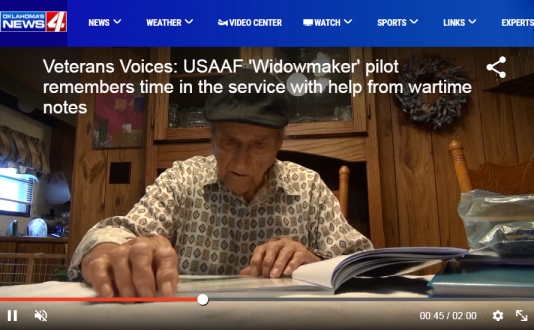
After the war, he returned to Army Air Force service and
reached the rank of Captain flying with B-29 Superfortress
units. In the photos below he can be seen on the right of
each photo. The photo on the right appears to be taken at
an Army Air Forces location.
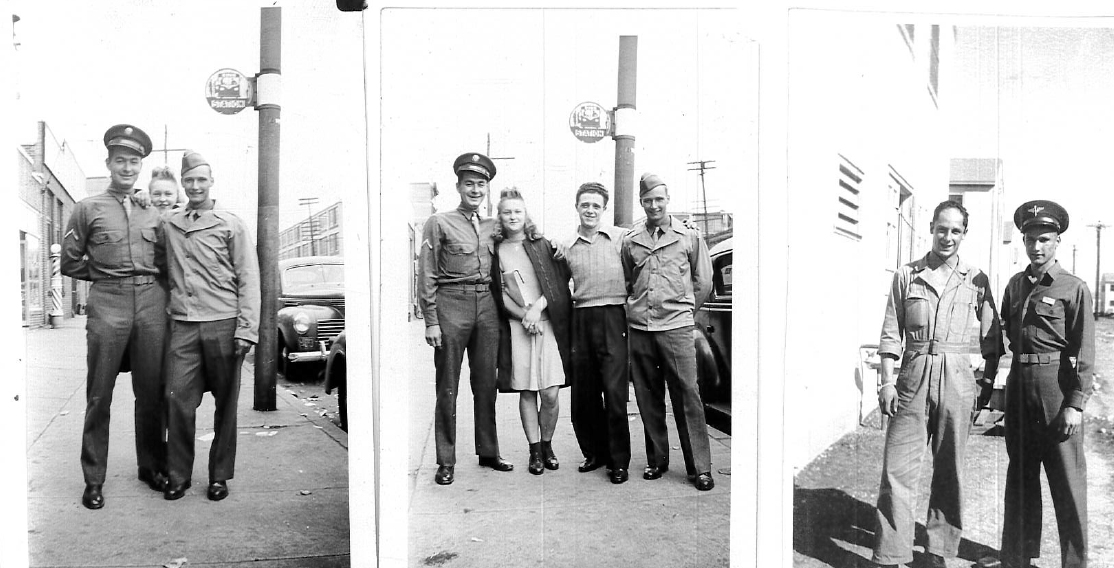
Enoch A MILES was the aircraft navigator on the day of
the crash. Enoch Miles was born in 1920 in Tennessee, the
son of Mary E and Jess R Miles. Just prior to the start of the
war, he was attending college at Athens, Georgia in the
University of Georgia where he studied Agricultural Engineering,
graduating in May 1942. His local paper occasionally
mentioned him, with the name Enoch Miles and Allen Miles being
used.
A US National Archives Report from the Military Attache in
Dublin recorded that Enoch was a temporary Air Transport Command
(ATC) replacement for a Frederick Sullivan who had been
hospitalised in Florida. It was not common for all B-26 combat
crews to carry a navigator and ATC had a pool of navigators who
would accompany ferry crews from North Africa to England. Combat
missions tended to use a navigator in selected aircraft in a
formation.
On the 12th of December 1944, he was a passenger on an ATC
Douglas C-54 Skymaster from Casablanca, Morrocco to New York. He
was among an assorted group of American and Allied passengers.
He appears to have stayed on in the services after the war, in
1954 he sailed from Bremerhaven with his family with a group of
US military personnel arriving into New York.
At some point after after this, Enoch changed his name to Allen Richard Miles, and it is with this name that he is remembered having died in May 1967 in Texas. His burial in Sam Houstan Cemetary in Texas shows his final rank as that of Major in the air force.
Richard W HARBORDT was born in 1923 to Katherine and George Harbordt, in Monterrey, Mexico. His parents were American, and his father worked as a metallurgist, an occupation that brought him all around the world during the 1920's and 1930's. Richard resided in Mexico with his family during his early years, sadly loosing his mother in 1924 when he was just over a year old. He attended Schreiner University in Kerrville, Texas, being mentioned in the local newspaper in 1940 as a student who had traveled from Mexico. Richard enlisted in the Air Force in January 1943 in Texas. He graduated as a Radio Operator from R/O School in Chicago, Illinois and served overseas for 11 months as a Radio Operator Mechanic. He completed his gunnery training along with Billy J kerr. He went on the fly with the 322nd Bomb Group but not in the same crew as the others in the crew. He returned home in January 1945, sailing into New York. He married his wife, Dorothy, in 1947 and after the birth of three children he was badly injured in a car accident in 1955. After a number of days in hospital, Richard passed away on the 15th of October 1955, aged just 32. The San Antonio Express published a short obituary for Richard after his death, part of which read: "Native of Monteroy, Mexico, he had been a resident of San Antonio for seven years. He was production manager for the Texson Clothing Company and a member of St Lukes Episcopal Church.
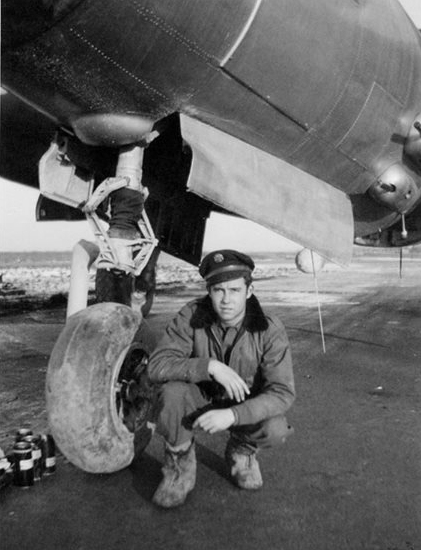 Billy J
KERR was born in 1923 in Armstrong, Texas to Sue and
Marshall M Kerr. By 1940 he was living in Claude, Texas with his
mother.
Billy J
KERR was born in 1923 in Armstrong, Texas to Sue and
Marshall M Kerr. By 1940 he was living in Claude, Texas with his
mother.
Billy enlisted in the Air Corps in November 1940. AS noted
above, he completed his gunnery training alongside Richard
Harbordt
He returned to America in August 1945 on a troop transport into
New York and was met there by his sweet heart Imogene Doyle. The
following month they were married in Claude, Texas. They had
three children and lived out their years in Claude. Billy passed
away in May 1988 in Armstrong county, Texas. Imogene passed away
in 2001. Billy never spoke to his family about his wartime
service but has left a number of artifacts and photos. One of
these is the image shown at right, which was annotated on the
back in hand writing Bill - 1945 - France. The B-26
Marauder medium bomb groups moved from their bases in the United
Kingdom to bases in France during 1944-45.
These photos of Billy were also provided, standing at and
sitting in a B-26 bomber.


The removal of the aircraft from the site in Skibereen involved
a salvage operation by an Irish Air Corps team of 15 men over 14
days, starting on the 17th March 1944. A detailed report
by the Irish Air Corps commander, Major W P Delamere records
that arrangements had been made to hand over the dismantled
aircraft to the Royal Air Force at Carrickcarnon border post on
April 4th 1944. The aircraft and salvage gear was
dispatched from Cork together and arrived at Baldonnel, outside
Dublin and headquarters of the Irish Air Corps, on the 2nd of
April. It was repacked and over the next two days it was
requested by the American military that they would in fact meet
the convoy at the border and thus arrangements with the RAF were
cancelled. The convoy was visited by the Major Sprague,
the US Military Attache in Ireland, on Monday the 3rd of April
and the next day the convoy was dispatched to meet the
American's at the border. Sadly, there was no one waiting
for the convoy and none had been there all day. F/Lt
Herbert Stanley Moore of the RAF who was at the post had to
request the Irish drivers to move the convoy 16 miles into
Northern Ireland where it could be safely parked. He then
drove the five Irish personnel back to Dundalk where they shared
a meal and he then may have driven them back to Baldonnel.
The arrival of the aircraft in Northern Ireland is recorded in
the Operations Record Book of the RAF's 226 Maintenance Unit.
Compiled in 2021 with the aid of the men's families who shared
information and photos. The Irish Army report on this
incident was the main source, file ref G2/X/1295 and
ACF-S-214. Records from ancestry.com were also consulted
along with the USAAF Official Form 14, crash report. The
Missing Air Crew Report #6117 and Max Bedell's Escape and
Evasion form were also sourced.
